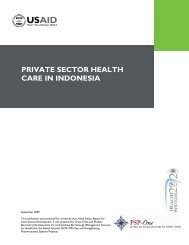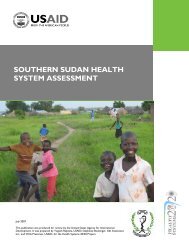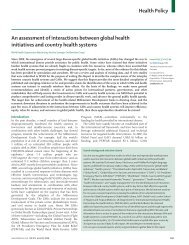Case Study on Piloting Complex Health Reforms in ... - PHRplus
Case Study on Piloting Complex Health Reforms in ... - PHRplus
Case Study on Piloting Complex Health Reforms in ... - PHRplus
Create successful ePaper yourself
Turn your PDF publications into a flip-book with our unique Google optimized e-Paper software.
2. Pilot C<strong>on</strong>text<br />
2.1 Emergence of the Pilot C<strong>on</strong>cept<br />
The pilot c<strong>on</strong>cept emerged <strong>in</strong> early 1994 as the MOH was pressured by the government of<br />
Kyrgyzstan to beg<strong>in</strong> implement<strong>in</strong>g two laws that had been enacted <strong>in</strong> 1992. The <strong>Health</strong> Protecti<strong>on</strong><br />
Act of the Kyrgyz Republic was passed <strong>on</strong> July 2, 1992, and outl<strong>in</strong>ed a program to:<br />
! Develop a framework of health protecti<strong>on</strong> and def<strong>in</strong>e measures to ensure rights of citizens to<br />
sanitati<strong>on</strong> and envir<strong>on</strong>mental health safety;<br />
! Shift priorities toward health promoti<strong>on</strong> and disease preventi<strong>on</strong> and focus <strong>on</strong> primary and<br />
family-based care;<br />
! Make changes <strong>in</strong> the form of health facility ownership; and<br />
! Diversify and decentralize health revenue sources, mandat<strong>in</strong>g that health care f<strong>in</strong>anc<strong>in</strong>g be<br />
moved partially “off-budget” with revenues com<strong>in</strong>g from special earmarked taxes and other<br />
services.<br />
The Law of the Kyrgyz Republic <strong>on</strong> Medical Insurance was passed <strong>on</strong> July 3, 1992, and<br />
described the requirements for mandatory and voluntary medical <strong>in</strong>surance. The Law <strong>in</strong>cluded a plan<br />
to create a health <strong>in</strong>surance fund <strong>in</strong> each oblast to be f<strong>in</strong>anced through a m<strong>in</strong>imum 6 percent payroll<br />
c<strong>on</strong>tributi<strong>on</strong> paid by employers, a per capita rate paid by the oblast government to cover n<strong>on</strong>-work<strong>in</strong>g<br />
and exempt populati<strong>on</strong>s (<strong>in</strong>clud<strong>in</strong>g employees of public budget organizati<strong>on</strong>s), and funds transferred<br />
from the current 34.5 percent Social Insurance and Pensi<strong>on</strong> Fund payroll tax. A subsequent Cab<strong>in</strong>et of<br />
M<strong>in</strong>isters decree stated that implementati<strong>on</strong> of the Medical Insurance Law would beg<strong>in</strong> <strong>on</strong> January 1,<br />
1995.<br />
Poor macro-ec<strong>on</strong>omic performance, a low tax revenue base, and a lack of technical capacity<br />
with<strong>in</strong> the health sector delayed implementati<strong>on</strong> of the 1992 health reform laws. But <strong>in</strong> early 1994,<br />
under pressure to meet the Cab<strong>in</strong>et of M<strong>in</strong>ister’s deadl<strong>in</strong>e, the MOH hoped to develop a plan to<br />
dem<strong>on</strong>strate a transiti<strong>on</strong> from a government-f<strong>in</strong>anced, centrally planned health system to a more<br />
efficient system of health service organizati<strong>on</strong> and delivery of care, with mixed (public and private)<br />
f<strong>in</strong>anc<strong>in</strong>g. Realiz<strong>in</strong>g that such ambitious attempts to <strong>in</strong>crease the efficiency of the health care system<br />
might have negative affects <strong>on</strong> access to and quality of care, the MOH planned an <strong>in</strong>itial pilot project<br />
<strong>in</strong> a def<strong>in</strong>ed geographic area. The pilot project would implement the Medical Insurance Law <strong>in</strong> a<br />
comprehensive way but <strong>on</strong> a limited scale, and use experience and less<strong>on</strong>s learned to plan for nati<strong>on</strong>al<br />
implementati<strong>on</strong> (Langenbrunner et al., 1994).<br />
USAID was simultaneously c<strong>on</strong>sider<strong>in</strong>g the c<strong>on</strong>cept of provid<strong>in</strong>g technical assistance <strong>in</strong><br />
dem<strong>on</strong>strati<strong>on</strong> or pilot sites, as a way to provide rapid-resp<strong>on</strong>se assistance <strong>on</strong> a wide range of health<br />
care f<strong>in</strong>anc<strong>in</strong>g and service delivery issues emerg<strong>in</strong>g throughout the former Soviet Uni<strong>on</strong>. USAID was<br />
fairly new to the regi<strong>on</strong> and “[t]here was c<strong>on</strong>siderable political pressure from the State Department<br />
2. Pilot C<strong>on</strong>text 3

















